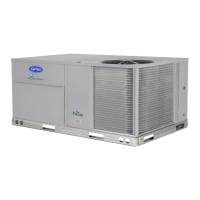38
After letting the power exhaust run and stabilize for 5 min-
utes, the control will verify E.PWR has increased and BP is
within BPSP ± AC_PE_DB.
If E.PWR has increased and BP is within BPSP ±
AC_PE_DB, PF.ST=PASS, otherwise SF.ST=FAIL.
Return Fan Auto-Component Test — The return
fan auto-component test requires the following conditions:
1. Unit is not shut down due to failure (A152).
2. Supply fan VFD not in bypass mode.
3. Return fan VFD not in bypass mode.
4. BP.CF=FAN TRACKING (Building pressure controlled
by keeping a constant difference between supply airflow
and return airflow).
5. Supply fan not on.
6. Power exhaust not on.
Test screen will display the following:
The return fan auto-component test will function by com-
manding the supply fan to minimum speed (STATPMIN), and
verifying that return VFD power (R.PWR) is increasing and
building pressure (BP) is decreasing.
Setting RF.TS=ON will perform the following:
1. Record R.PWR, D.CFM, and BP.
2. Command S.VFD to STATPMIN.
3. Open economizer to ECONOMIN.
4. Allow building pressure task to modulate R.VFD and let
run 5 minutes.
5. Verify R.PWR increases.
6. Verify D.CFM increases
7. Verify BP increases.
8. End test.
After letting the return fan run and stabilize for 5 minutes,
the control will verify R.PWR has increased and BP has
changed.
If R.PWR has increased and BP has changed,
RF.ST=PASS, otherwise RF.ST=FAIL.
Condenser Fans (Outdoor Fans) Auto-Compo-
nent Test —
The condenser fans auto-component test re-
quires the following conditions:
1. Unit is not shut down due to failure (A152).
2. OAT>70 F.
3. No compressors are on or requested on.
4. All compressors are available for staging.
Test screen will display the following:
The condenser fans auto-component test functions by com-
manding to ON all compressors and outdoor fans and verify
that Saturated Condensate Temperature (SCT) is less than the
calculated SCA.H and SCB.H for the corresponding circuit.
SCA.H and SCB.H depend on OAT and are different for each
unit size and circuit, see Plot D, Fig. 6.
Setting CF.TS=ON will perform the following:
1. Command supply fan ON.
2. Command all condenser fans ON.
3. Stage all compressors ON.
4. Let compressors run for 5 minutes.
5. Verify SCT.A < SCA.H and SCT.B <SCB.H.
6. End test.
After letting the condenser fans run and stabilize for 5 min-
utes, the control will verify SCT.A<SCA.H and SCT.B <
SCB.H.
If SCT.A<SCA.H and SCT.B<SCB.H, CF.ST=PASS, oth-
erwise CF.ST=FAIL.
Economizer Auto-Component Test — The econo-
mizer auto-component test requires the following conditions:
1. Unit is not shut down due to failure (A152).
2. EC.EN=YES (Economizer is enabled).
3. ABS (OAT-RAT)>10 F. (There is at least 10F difference
between OAT and RAT).
4. Supply fan VFD not in bypass mode.
5. Power exhaust or return fan (if enabled) not in bypass
mode.
6. Supply fan not on.
Test screen will display the following:
The economizer auto-component test will verify economiz-
er operation at the 0% and 100% position. It will perform this
test by commanding the supply fan to minimum speed
(STATPMIN), modulating the economizer position, and veri-
fying SAT changes to within the auto-component test econo-
mizer deadband (AC_EC_DB) of OAT and RAT. AC_EC_DB
will default to 4 F with a range of 0 to 10 F.
RF.TS OFF
RF.DT Running
S.VFD 0%
R.VFD 0%
R.PWR 0.00 kW
D.CFM 0 cfm
BP 0.00 H20
RF.TS Fail
CF.TS ON
SCT.A 105.3 F
SCA.H 115.0 F
SCT.B 108.3 F
SCB.H 117.0 F
OAT 76.3 F
CF.ST Running
EC.TS ON
S.VFD 20.0 %
E.POS 100.0 %
O.CFM 4000 cfm
OAT 65 F
RAT 75 F
SAT 65 F
MAT 65 F
EC.ST Running
150
140
130
120
60
80
100
120
SCT MAX (F)
Outdoor Air Temperature (F)
SCTA
Poly. (Avg)
SCTB
y = 0.0057x
2
+ 2.0025x
2
- 13.752
R
2
= 0.9918
Avg
110
100
90
80
Fig. 6 — Plot D: SCT MAX vs OAT
a48-8788

